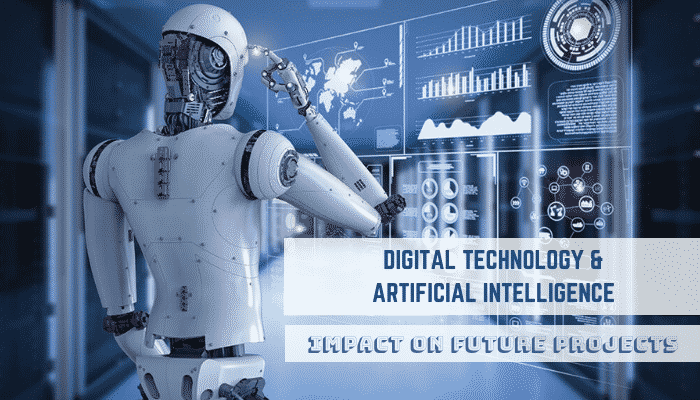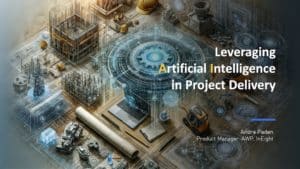Digital Technology and Artificial Intelligence aligned with 3D modeling and BIM (Building Information Modelling) are leading Project Management and Project Controls into a whole new era of systems and management techniques. For the last 50 years, there has been little change in the approach and techniques that have been applied to projects but all that is now changing rapidly. In order to take these changes onboard, there is a need for Company Management to investigate how these new technologies can and should be applied to their projects and organization.
In this article, I am attempting to identify some of the current functions and practices that will be changed in the future as a result of applying new technologies. The Board of Directors has to understand and support these changes in order for their companies to prosper, it needs to be driven from the top or it will not be successfully implemented.
Firstly I am reviewing how these new technologies will impact on a Client Organization, but I will also indicate where I believe that the supporting Suppliers, Manufacturers, and Contractors will need to adjust in order to support the future projects.
Impact of New Technologies on Gate Stages
At FEL Gate 1, Initialization, the company needs to decide if:
- The projects in FEL 1 address a true business need
- The alternatives for meeting business goals were explored thoroughly
- The economic analysis used to evaluate potential benefits was robust
- The conceptual estimate and schedule was accurate
Future estimates and schedules will be able to be generated from 3D modeling data, which will generate more detailed and accurate estimates and schedules. Summary 3D models will also give the company better pictorial information about potential environmental impacts, however, this will require the client organization employing 3D modeling staff, who will probably be younger people with the gaming experience.
At FEL Gate 2, Scope Selection, the company needs to:
- Confirm feasibility
- Select technology and define process design
- Refine cost estimate and identify risks
Overall plant layouts will be generated from the 3D models, supported by contractors if required. Updated Schedules (4D model – Time) and cost estimates (5D model – Cost) will be automatically produced from the model and application of BIM data.
At FEL Gate 3, Basic Engineering, the company needs to:
- Fully define the scope
- Generate the technical information necessary to contract the execution of the project
- Refine the estimates and economic analysis
More detailed plant layouts will be generated from the 3D models (currently the plot plan precedes the 3D model), which will probably in future be produced and managed by contractors, with walkthroughs available for operational and maintenance reviews (6D model – Performance). Refined cost estimates and schedules will be automatically produced from the model and application of BIM data.
At FEL Gate 4, Execution, the client will be monitoring EPC contractors’ progress in detailed engineering design, procurement, construction and installation of the project. The contractors will provide cost and progress data from the 3D/4D/5D/6D models.
Impact of New Technologies on Project Management
The Project Managers role will still be to manage the project team and report the status and risks to senior management through all of these gate stages. However, the roles and responsibilities of the project management team will change significantly with the impact of Artificial Intelligence (AI) and BIM.
Impact of New Technologies on Planning and Scheduling
Planning defines WHAT and HOW, while scheduling defines WHO and WHEN. When this is related to a 3D model, the build sequence is initially determined by the model construction (i.e. which corner of the site do we start in) with predetermined sequences between trades. (i.e. construct the foundations then erect the steel.) Therefore the logic of the plan is mostly predetermined and the schedulers’ role is to determine the activity durations to create the 4D model.
The client Planners role is to work with other team members to identify the construction start point and subsequent trade deployments in conjunction with planning the Engineering and Procurement to support this logic. They will also need to take into consideration system completions, commissioning, handover, and start-up functions to enable an availability date to be arrived at for use by the Sales and Marketing staff.
The next generation of 3D/4D modeling software will automatically link to the planning software packages, so that logic plans could be automatically compiled. The duration of these activities will be calculated using the quantities in the 3D model and applying rate tables to derive resource requirements. These rate tables will also need to take into account the variable factors for location and culture as executing a project in different countries will require different man-hours. ‘What if’ scenarios will then be required to see the effects of say two cranes instead of one, or two welding crews instead of one, on the overall duration.
The client planning and scheduling functions during FEL gate 1 will be to derive the probable overall schedule, whilst during the other gate stages they will be reviewing and validating contractors submissions of logic, durations, and progress whilst carrying out ‘what if’ scenarios and risk assessments.
Impact of New Technologies on Cost Estimating
Quantities are available from the model. These are priced by applying standard SAP costs collected from suppliers and vendors. The client’s estimator will need to work with the engineers on assigning the correct project specifications when choosing the appropriate rate to apply. The scheduler will provide man-hours and trades and the estimator will apply standard rates to these. Construction equipment and other costs will be estimated accordingly using in-house data. For all of these rates, the estimator will be required to allocate productivity, location and culture factors to derive the anticipated overall project cost. At FEL gate 1 this will be applied to high-level summary data to derive the anticipated project costs for sales and marketing application. At other gate stages, the detailed estimates will be provided by contractors and the client’s estimators will adjust and validate and include the client’s own costs, to derive the overall anticipated project cost.
Impact of New Technologies on Cost Controls
The client’s cost engineers will collect actual costs and validate with budget allocation to generate the updated project cost at completion. Most actual cost data will be provided by contractors who will collect it from automatic updates of the 3D/4D/5D model progress, applying supplier and contractor agreed rates and milestone payments.
Forecasting ‘what if’ scenarios and risk assessment pricing will be a major function to maintain their cost at completion forecast, using the estimating 3D/4D/5D model data as the basis, as this will be maintained as current pricing data by the contractors and suppliers.
Impact of New Technologies on Document Controls
Whilst the project will be managed and reported using the 3D model there will still be a significant requirement to use 2D documentation in the field, and this will need to be controlled in a similar fashion to present. However, there will be a requirement for 3D monitors to be installed in the field so that local construction management can also use it for construction sequencing and clash detection.
Impact of New Technologies on Coding
One of the major functions that need to be client driven is the application of common coding for the projects. This should cover code of accounts (COA), work breakdown structures (WBS), organisation breakdown structures (OBS), equipment and materials SAP codes, international rate tables for labour and construction equipment, standard location culture and productivity factors for each region of the world, and application of BIM standards along with BSI and existing ISO standards.
Impact of New Technologies on Progress Measurement
Methods for measuring model completion will need to be agreed, as this will be the major design tool for future engineering. Progress measurement for 2D drawing production will remain as is. Procurement will be driven from the model with standard terms and conditions applied, so progress measurement will need to be adjusted. Similarly, contracts will also be model driven. Field construction progress will be calculated from drone assessment of the actual status against the model, probably by flying through the site on a daily basis or by using 3D headsets with quantity surveyors updating progress directly to the model.
Impact of New Technologies on Accountants
Because the model will be maintained to reflect actual status on a daily basis then accounts due for payment will also be automatically updated and presented to the client for payment on an agreed basis. Actual payments will be advised to the client’s project team for incorporation into cost and project reporting.
Impact of New Technologies on Suppliers/Manufacturers role
A purchase requisition will be generated from the model indicating the specification requirements and quantities, which will then be distributed to approved suppliers electronically. They will then investigate this requisition and respond with their pricing and delivery quotation. If successful then they will be required to submit a model of their items for incorporation by the contractor into the overall project model. They will be required to submit progress statements using electronic model status, which the client and contractor may choose to validate. When the items are ready for shipment then they will be inspected as at present. The contractor will coordinate shipments to the site so that materials arrive in a coordinated and timely manner to suit construction.
Impact of New Technologies on Contractors Role
The contractor will be responsible for managing the project 3D/4D/5D/6D model and enhancing it with supplier/manufacturers models when submitted. From this project model, sub-contract requisitions will be generated and handled in a similar way to equipment and material items. The major contractor will manage all access to the project model, restricting access to confidential information as required.
This is a very high-level assessment of the client’s role on a future project utilizing 3D/4D/5D/6D models. It will not happen unless the Company Board of Directors understands the changes required and supports these technical and people changes completely.
How do you think your organization will incorporate these changes?
Disclaimer: This article is the sole opinion of the author, Tony Cort
About The Author, Tony Cort
Tony has over 40 years experience in the petrochemical and nuclear industries covering both offshore and onshore work.
He has worked on engineering and construction phases of many projects and has completed working assignments both in the UK, Europe, Middle East, Far East, and Canada. He has also been responsible for managing an organization, staffing, training, procedures, and input into proposals, as well as being a Company Representative for client liaison and contract negotiations.
He has now semi-retired and is a training consultant.
Connect with Tony via LinkedIn or email at [email protected].






![[Free 90-min Masterclass] The Ultimate Leadership Recipe for Project Professionals](https://www.projectcontrolacademy.com/wp-content/uploads/2024/08/4-1024x576.jpg)















